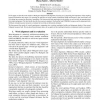Free Online Productivity Tools
i2Speak
i2Symbol
i2OCR
iTex2Img
iWeb2Print
iWeb2Shot
i2Type
iPdf2Split
iPdf2Merge
i2Bopomofo
i2Arabic
i2Style
i2Image
i2PDF
iLatex2Rtf
Sci2ools
LREC
2008
2008
Portuguese-English Word Alignment: some Experiments
In this paper we describe some studies of Portuguese-English word alignment, focusing on (i) measuring the importance of the coupling between dictionaries and corpus; (ii) assessing the relevance of using syntactic information (POS and lemma) or just word forms, and (iii) taking into account the direction of translation. We first provide some motivation for the studies, as well as insist in separating type from token anlignment. We then briefly describe the resources employed: the EuroParl and COMPARA corpora, and the alignment tools, NATools, introducing some measures to evaluate the two kinds of dictionaries obtained. We then present the results of several experiments, comparing sizes, overlap, translation fertility and alignment density of the several bilingual resources built. We also describe preliminary data as far as quality of the resulting dictionaries or alignment results is concerned.
| Added | 29 Oct 2010 |
| Updated | 29 Oct 2010 |
| Type | Conference |
| Year | 2008 |
| Where | LREC |
| Authors | Diana Santos, Alberto Simões |
Comments (0)

